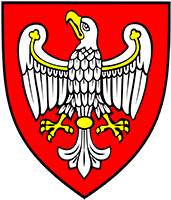Economy
In Wielkopolska, unemployed persons account for 5.3% (July 2016) of the total number of people capable of working.

| Stopa bezrobocia (GUS 2016 r.) |
Unemployment rate (Central Statistical Office of Poland, 2016) |
| Wielkopolska |
Wielkopolska |
| 5,3 |
5.3 |
| 8,6 |
8.6 |
| Polska |
Poland |
Wielkopolska is one of the most economically developed regions in the country and is characterised by a high concentration of foreign capital. The economic situation of the region is determined by factors such as the sustainable rate of economic growth, high industrialisation and advanced technological level. Investment attractiveness of the voivodeship is confirmed by other large investments located in the region. Factors such as a high level of special education at universities in the Wielkopolska Region and a number of potential business partners and suppliers have an influence on this effect.
Higher education institutions in Wielkopolska provide the region with well-qualified employees. Poznań is one of the largest academic centres in Poland. It has 38 higher education institutions, the most outstanding of which include the Adam Mickiewicz University with a student population of nearly 40 thousand, Poznań University of Technology, University of Economics and Business, University of Life Sciences and University of Medical Sciences. The total number of students in the Wielkopolska Region amounts to nearly 143 thousand. Apart from Poznań, there are also academic centres in Gniezno, Jarocin, Kalisz, Konin, Leszno and Piła.
Universities in Poznań offer attractive programmes of studies including: Production Management and Engineering, Computer Science or Bioinformatics, Economy, Accounting and Finance, Biotechnology, Neurobiology, Pharmacy, Electronics and Communication, Electrical Engineering, Mechanics and Machinery Construction, Mechanics and Machine Design, Automation and Robotics, Materials Engineering, Biomedical Engineering, Commodity Science, and many more.
In 2014, the Wielkopolska Region ranked third in Poland in terms of the amount of invested foreign capital, which accounted for 7.7% (over PLN 16.5 billion). Currently, 411,416 businesses (as at 31 July 2016), including 7,263 entities with foreign capital, operate in Wielkopolska.

| Podmioty gospodarcze w województwie… |
National business entities by the scope of activity (Central Statistical Office of Poland, 2013) |
| Przetwórstwo.. |
Industrial processing |
| Handel/naprawa pojazdów samochodowych |
Trade/repair of motor vehicles |
| Działalność finansowa… |
Financial and insurance activities |
| Działalność profesjonalna,… |
Professional, scientific and technical activities |
| Budownictwo |
Construction sector |
| Transport… |
Transport and warehouse management |
| Obsługa rynku…. |
Real estate services |
| Opieka zdrowotna … |
Health care and social welfare |
NATIONAL BUSINESS ENTITIES BY THE SCOPE OF ACTIVITY (Central Statistical Office of Poland, 2015)
Trade/repair of motor vehicles – 25.66%
Construction sector – 12.68%
Industry – 10.27%
Professional, scientific and technical activity – 9.71%
Transport and warehouse management – 5.89%
Health care and social welfare – 5.36%
Real estate services – 4.14%
Education – 3.43%
EMPLOYMENT IN THE ENTERPRISE SECTOR (Central Statistical Office of Poland, 2015)
Industry – 46.80%
Trade/repair of motor vehicles – 29.92%
Transport and warehouse management – 6.39%
Construction sector – 5.29%
Administration and support activity – 4.20%
Professional, scientific and technical activity – 2.15%
Information and communication – 1.53%
Real estate services – 1.10%
The largest companies which have invested in Wielkopolska include representatives of the following industries:
- Automotive (Volkswagen, MAN, Bridgestone, Solaris Bus&Coach, Inter Groclin),
- Food (Kompania Piwowarska, Imperial Tobbaco Polska, Dino, WrigleyPoland Sp. z o.o., Nestle),
- Transport and logistics (Amazon, Raben Group, Kuehne + Nagel),
- Electronics (Samsung Electronics),
- BPO/SSC (Arvato Services, Contact Center, Holicon, Franklin Templeton),
- Pharmaceutics and Beauty (GK GlaxoSmithKline Pharmaceuticals, Nivea),
- Airlines (Pratt&Whitney Kalisz Sp. z o.o.).
Wielkopolska puts a strong focus on cooperation between the scientific and research institutes and the business. The Regional Innovation Strategy for the Wielkopolska Region for 2010-2020 provides that support for the science sector will lead to a real increase in the quality of conducted scientific research, will expand research areas corresponding to real economic needs, and will result in creating effective mechanisms for cooperating with enterprises.
The Wielkopolska Region has determined its own economic and social priorities within so-called smart specialisations, i.e., areas which, thanks to the science sector support and the available business potential, can generate goods and services and also compete in the global marketplace.
As a result of analytical works and ongoing entrepreneurial discovery process, the following 6 areas of smart specialisations have been identified: bio-resources, future interiors, industry of tomorrow, specialised logistical processes, development based on ICT, modern medical technologies.
Poznań is a large BPO (Business Process Outsourcing) and SSC (Shared Services Centres) centre. At the same time, the priority sectors for the capital of the region are: technologically advanced production, research and development (R&D), convention and exhibition activity, and recreational and entertainment infrastructure. Most of the foreign capital which has been invested in Poznań has come from Germany, Great Britain, USA, France, Japan, Sweden, Spain, Netherlands and Republic of South Africa.
Fitch Ratings, international rating agency, has confirmed ratings for Wielkopolska as for the debt in the foreign currency at the “A-“ level, for the debt in the national currency at the “A” level, and a long-term national rating at the “AAA(pol)” level. The outlook on all ratings is stable.
In 2014, Wielkopolska generated 9.7% of the Polish GDP. Thus, it ranked third among other regions in the country. In comparison to 2013, the value of the GDP generated in the Wielkopolska Region had increased by 0.1%.
GDP figures for 2014 (source: Central Statistical Office of Poland)
Dane na temat Produktu Krajowego Brutto w roku 2014 (źródło GUS)
| GDP in Poland |
GDP in Wielkopolska |
| PLN 1,719,097 million |
PLN 166,752 million |
| 100% |
9.7% |







